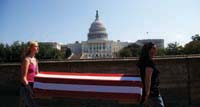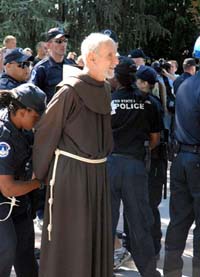The names of dead American soldiers and Iraqi civilians echoed up and down the seven floors of balconies that overlook the inner atrium of the Senate Hart Office Building. In the center of the atrium circled people from all across the U.S., joining hands in protest against the war and calling for a declaration of peace. Religious leaders in the garments of their denominations read scripture and called for the “beating of swords into plowshares” and “spears into pruning hooks.” Capitol Police repeatedly warned the group to disperse. Finally, as the police with fists full of plastic handcuffs encircled the protest to initiate arrests, a spontaneous die-in began with one person after another falling to the floor. Those arrested were accompanied by hundreds of on-lookers, mostly Senate office staff lining the balconies as the reading of the names of the dead continued. Hundreds more people were outside the buildings, some arrested for refusing to move from the steps of the Russell Senate Building as well as others along the path leading to the Capitol itself where protestors carried a coffin and photos of those killed in Iraq.
This demonstration at the Senate office buildings on September 26, 2006 was preceded the week before with arrests outside the White House and followed the next day with arrests outside the Rayburn House Office Building. The White House events initiated the Declaration of Peace’s Week of Action, not only in Washington, DC, but all around the country as well as solidarity actions in Australia, Italy, and Puerto Rico. Over 375 separate actions took place in nearly every state across the country, including vigils, peace concerts, teach-ins, closing down military recruiting stations, calling congressional representatives, protesting corporations profiting from the war (such as Bechtel), and risking arrest by civil disobedience. Over 265 people were arrested in 22 cities.
The Declaration of Peace campaign is a nationally coordinated, grassroots effort that embodied this conviction: If the people lead, the leaders will follow. Some of the coalition groups include Pace E Bene, American Friends Service Committee, United for Peace and Justice, Network of Spiritual Progressives, Global Exchange, US Labor against the War, Buddhist Peace Fellowship, Baptist Peace Fellowship, Catholics for Peace and Justice, The Shalom Center, and many more. The campaign calls on the U.S. Congress to end the occupation of Iraq and begin a comprehensive plan for peace. The Week of Action resulted from the failure of the U.S. Congress to meet the Declaration of Peace deadline of September 21st, the International Day of Peace. Months before this deadline, US citizens around the country met with their Senators and House Representatives to invite them to join the campaign for peace by signing the Declaration of Peace Congressional Pledge.
The Pledge commits the Congressional leaders to support the 8 Principles of Peace including: 1) rapid withdrawal of US troops and coalition forces, with no future redeployments, 2) no permanent US military bases in Iraq, 3) support for an Iraqi led peace process, including a peace conference to shape post-occupation transition, 4) return of Iraqi control over its oil resources and the political and economic life of the nation, 5) reparations and reconstruction to address the US invasion, occupation, and 13 years of sanctions, 6) establish a “peace dividend” for social needs in the US, 7) increased support for US veterans, and 8) no so-called “preventive” war against Iran or any other nation. Eleven members of Congress have signed the Pledge, while many others have given their verbal support and point to similar resolutions they’ve signed in congress.
The Declaration of Peace was remarkable in three respects. First, it was an explicitly nonviolent campaign in which all participants committed themselves to Nonviolent Guidelines for any Declaration of Peace action. These guidelines included upholding an attitude of openness and respect toward all, no use of verbal or physical violence toward any person, no destruction of property, and acceptance of the consequences of our actions. Perhaps as a result of these actions, substantive and productive dialogue was possible between dissenting sides, including Congressional staff as well as arresting police and undercover intelligence officers. In these conversations, many of those who work for the government shared their internal conflict between official duties to uphold the war and personal convictions to seek peace.
A second aspect is the participation of official religious leadership, breaking the silence and declaring public support for peace. Nearly half of the Campaign’s 500 endorsing organizations came from the faith-based community, including both large national organizations as well as individual congregations. Religious leadership participated in the congressional delegations prior to the September 21 deadline, spoke from the pulpit of the abiding human need for peace, and initiated the actions at the Senate office buildings with an inter-faith ceremony with leaders of Buddhist, Christian, Jewish and Islamic faiths.
A final aspect is the geographic and political inclusivity of the campaign. Supporters are from every single state, with over 16,000 people signing the Declaration of Peace pledging to take nonviolent steps in calling on Congress to act. Actions took place not only in the largest metropolitan areas, but also in small towns and communities, such as Salina, Kansas, where local organizing has included hunger fasts, parades, teach-ins, drive-by protests outside the local military base, and a song dedicated to the campaign. The Declaration of Peace has remained non-partisan with participation from all political parties, including Democrats, Republicans, and Greens. Veterans groups have joined in with endorsements from Veterans for Peace, Gold Star Families, Military Families Speak Out, and Iraq Veterans Against the War.
The Declaration of Peace campaign continues until the objective of a just and comprehensive plan for peace in Iraq is implemented. The pledge called for the plan to be established and activated by Sept. 21st, 2006 and completed by March 19th, 2007. The coalition continues to gather, plan, and participate in nonviolent resistance across the country, especially gearing up for March 19th if the situation in Iraq continues. Directly following the Week of Action, groups mobilized to make the Fall national elections a referendum on the war. With the new Congress, organizers are appealing for a new beginning of an end to the U.S.-led occupation. The campaign also supports efforts to meet needs of returning Iraq war veterans, preparation for potential civil disobedience through nonviolence training, and divesting from corporate interests that have benefited from war.
Organizers are also beginning to reach out to US government leadership to support the drafting of legislation and policy that can lead to a long-awaited for and universally supported official declaration of peace. Some members of the coalition have issued a “mandate for peace” for people to sign and send to congress. This mandate calls on congress “in its earliest days to pass legislation requiring the prompt removal of US troops from Iraq and discontinuous funding for military purposes in Iraq except for the safe withdrawal of all US troops.”
According to Ken Butigan of Pace e Bene, a national organizer for the Declaration of Peace: "Far too often, we find ourselves declaring war: with ourselves, in our families, between our communities, against other nations and against the earth. The Declaration of Peace has been an opportunity to ‘declare peace’ in a public way using the most powerful language we have at our disposal: our own spirited bodies. Thousands of people across the United States took action with the Declaration of Peace to say in an unmistakable way that now is the time to support a new course on Itaq for a just and lasting peace."
Jennifer Kuiper is Executive Director of the Metta Center for Nonviolence Education in Berkeley, Calif. and a national organizer for the Declaration of Peace.
Declaration of Peace: www.declarationofpeace.org
Pace E Bene: www.pacebene.org
Veterans for Peace: www.veteransforpeace.org
United for Peace and Justice: www.unitedforpeace.org
US Labor Against War: www.uslaw.org
American Friends Service Committee: www.afsc.org
Mandate for Peace: www.mandateforpeace.org


